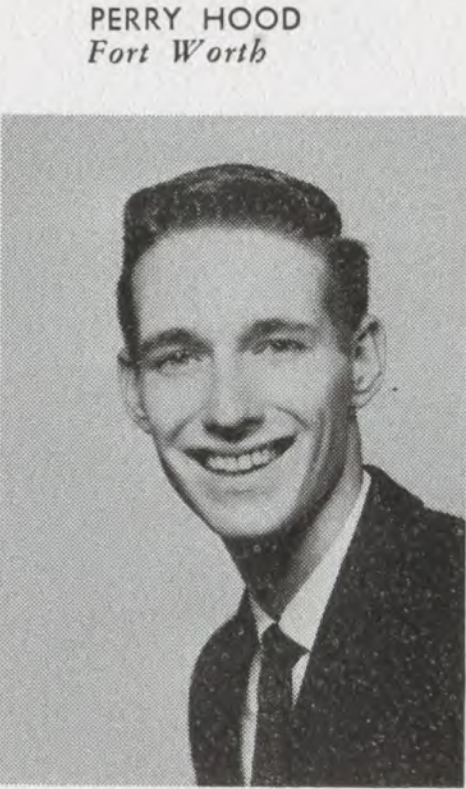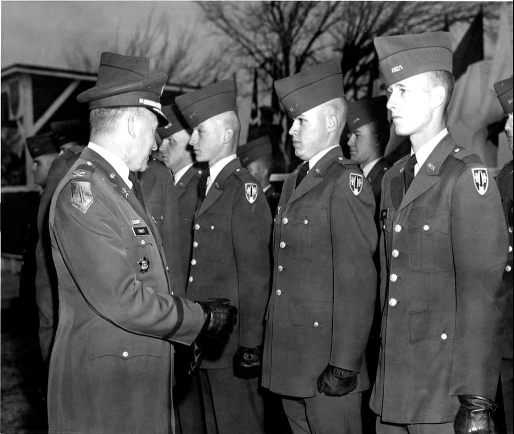A Frog in the Jungle

1961 The Horned Frog.
Charles Perry Hood Jr., who went by Perry, was a Texas Christian University student who served two tours in Vietnam. Throughout his life, Perry continued his parents’ rich history of military service and love of country. Perry chose to honorably serve his country when so many others at this time chose to abscond.
Perry was born September 24, 1942, to Charles Hood, a WWII fighter pilot and Texas Christian University alumnus, and Frances Davis Hood, a University of Virginia’s Nursing School graduate, and WWII Army nurse.[1] Perry, a Fort Worth native, attended Arlington Heights High school and was a member of the JROTC program.[2] After high school, he attended TCU for one year and was a member of the Canterbury Club, an Episcopal organization.[3] After leaving TCU, he became an honored Tarrant County Junior Achievement Advisor, and in 1964, he moved to Amarillo and was nominated to Postmaster.[4] In 1966, he was commissioned as an Army Reserve 2nd Lieutenant and assigned to Gulf Battery, 6th Artillery Battalion, an Anti-Air Defense Artillery Battery out of Ft. Bliss, Texas.[5] In April 1966, before leaving for Vietnam, Perry met and married Patricia Kenny, a Texas Western College graduate, and El Paso native.[6]
Unlike many soldiers who chose to defer deployments to Vietnam while in a reserve or national guard unit, Perry chose to go. His first tour lasted thirteen months, from October 1966 to November 1967.[7] Gulf Battery’s anti-air defense weapons were the tank-like M-42 “duster” which had twin 40-millimeter automatic cannons, and the unit’s jeep-mounted quad 50-caliber machine guns. Although there wasn’t much need for anti-air weapons in Vietnam, the United States used them to support the ground forces with direct fire, escort security, and positional and base security.[8] While serving as a platoon leader for Gulf Battery, their first mission in Vietnam was dangerous at best. They convoyed ninety-three miles, from DaNang to the Demilitarized Zone via the contested Route 1. After the nine-hour convoy, Gulf Battery linked up with their commanding element, 1st battalion, 44th Artillery Regiment in support of the Marines in Leatherneck Square.[9] Perry’s unit fiercely supported the Marines in Operation Kingfisher, Operation Beacon Hill, and the defense of Marine base Con Thien.[10]

Artillery OCS Alumni. 1966. “OCS Class 66-1.” Facebook. February 2017.
After his first deployment, the newly promoted Captain Perry Hood chose to become an Army Cobra helicopter pilot and return to Vietnam in October 1969 with Charlie or “Cobra” Troop, 1st Squadron, 9th Cavalry, 1st Cavalry Division.[11] Although he was trained on the Huey and the Cobra helicopter platforms, he was assigned to pilot the LOACH, a small scouting helicopter.[12] At this time, most Cobra units forced their new pilots to fly the LOACH until they had an open Cobra to assign them.[13] This was the case for Perry, who was appointed as the LOACH scouting platoon leader in November.[14] In 1969, the unit’s missions were primarily hunter-killer missions. These missions involved the Cobra gunships and the Loach working side-by-side as the LOACH would fly at ground level scouting for enemy locations or movements and regularly draw in the enemy fire as the cobra hovered overhead, awaiting enemy contact or target locations to destroy.[15] While conducting a hunter-killer mission eleven kilometers northeast of Song Be City Airfield, on December 12, 1969, Perry’s LOACH took a direct hit from an enemy machine gun, killing him instantly.[16]
Captain Charles Perry Hood was awarded the Silver Star, Bronze Star for Valor, Bronze Star for Merit, the Purple Heart, and the Air Medal for all his devoted duties while in service. He was buried on December 23, 1969, at the National Cemetery in Fort Bliss, leaving behind his pregnant wife and unborn son Kevin.[17] Flags were lowered to half-mast across Texas, memorializing Perry’s patriotic sacrifice to this country.[18] Perry’s name is honorably recorded on Texas Christian University’s Veteran Plaza and the National Vietnam Veterans Memorial.[19]
Perry was molded by his family’s past service, and he followed in his father’s footsteps throughout his life, from joining high school JROTC, attending Texas Christian University, commissioning as a reserve officer, and becoming an Army pilot.[20] Perry was the opposite of the growing anti-war movement, for he knew that people like himself had to volunteer and serve to end the increasing threat of communism. He wanted a justifiable end to this conflict, as his wife Patricia stated, “he was strongly committed to the effort, but he was anxious to see a settlement. Perry wanted an end one way or the other… not just this in-between thing it seems to be now.”[21]

Song Be City Airfield, Vietnam, 1969
Photograph Charles P. Hood. Wall of Faces.
[1] “Birth of son Announced” Fort Worth Star-Telegram, September 27, 1942, 31; Freshman Class Photo, The Horned Frog (1933), 236, Special Collections, Mary Couts Burnett Library, Texas Christian University; “Fort Worth Reservist on Puerto Rico Duty” Fort Worth Star-Telegram, October 15, 1940, 8; “Frances D. Hood” Fort Worth Star-Telegram, February 9, 1997, 45.
[2] “JROTC,” The Yellow Jacket, 1958, 78, Arlington Heights High School, https://www.ancestry.com/sharing/30166268?h=ae87b2.
[3] Freshman Class Photo and Canterbury Club, The Horned Frog (1961), 202, 414, Special Collections, Mary Couts Burnett Library, Texas Christian University.
[4] “Advisors Thanked for Help” Fort Worth Star-Telegram, June 5, 1963, 23; “Three Eligible for Postmaster” El Paso Times, September 30, 1964, 1.
[5] “Charles Perry Hood Jr Class 1-66-Artillery OCS Alumni,” Artillery OCS Alumni, July 16, 2002, https://artilleryocsalumni.com/vietnam/hoodcp.pdf.; “El Pasoans Take Vietnam Convoy on ‘Road Without Joy’” El Paso Herald Post, December 13, 1966, 1, 15.
[6] “C.P. Hood Jr., Fiancée Wed” Fort Worth Star-Telegram April 16, 1966, 15.
[7] “Service Pending for Ft. Worth Pilot” Fort Worth Star-Telegram, December 19, 1969, 13.
[8] Gary L. Telfer, U.S. Marines in Vietnam: Fighting the North Vietnamese, 1967 (Washington D.C.: Normandy Press, 1984), 20,126.
[9] El Paso Herald Post, “El Pasoans Vietnam,” 1, 15.; George C. Herring, America’s Longest War: The United States and Vietnam, 1950-1975 (New York, NY: McGraw-Hill Education, 1986), 153.
[10] Telfer, U.S. Marines in Vietnam, 19-22, 129-133.
[11] Matthew Brennan, ed. Headhunters: Stories from the 1st Squadron, 9th Calvary in Vietnam, 1965- 1971 (Navato, CA: Presidio Press, 1987), 132, 157; “Charles Perry Hood Jr Class,” Artillery OCS Alumni.
[12] “Service Pending,” Fort Worth Star-Telegram, 13.
[13] Philip D. Chinnery, Vietnam: The Helicopter War (Annapolis, MD: Naval Institute Press, 1991), 162.
[14] Troop C, 1st Squadron, 9th Cavalry, Operational Report, Texas Tech University, 1969, https://www.vietnam.ttu.edu/virtualarchive/items.php?item=3040126003.
[15] Chinnery, Vietnam, 162-165; Brennan, Headhunters, 221-230.
[16] The Coffelt Database of Vietnam casualties, October 24, 2022, http://www.coffeltdatabase.org/detreq2.php.
[17] The Coffelt Database of Vietnam casualties; “Funeral Today in El Paso for Capt. Charles Hood,” Fort Worth Star-Telegram, December 23, 1969, 13.
[18] “EP Dips Flags to Honor Hero,” El Paso Times, December 22, 1969.
[19] Texas Christian University, “Roll of Honor,” TCU Veterans Services, November 29, 2022, https://veteransservices.tcu.edu/roll-of-honor/; Charles Perry Hood, Wall of Faces, November 28, 2022, https://www.vvmf.org/Wall-of-Faces/23979/CHARLES-P-HOOD-JR/.
[20] ROTC, The Panther, 1932, 84, Central High School, https://www.ancestry.com/sharing/167850?token=wnv1udMhGIt1r8qjpTXhPKiPG%2F3sp24chJdCrOJpm5A%3D; The Horned Frog, 1940, 8; “Infantry Officer Leaves for Duty with Air Corps,” Fort Worth Star-Telegram, September 4, 1940, 16.
[21] “Service Pending,” Fort Worth Star-Telegram, 13.
For Further Reading
Brennan, Matthew, ed. Headhunters: Stories from the 1st Squadron, 9th Calvary in Vietnam, 1965- 1971 (Navato, CA: Presidio Press, 1987).
Matthew Brennan’s Headhunters presents firsthand accounts of the soldiers involved in the newly implemented and highly successful 9th Calvary Air Assault unit during the Vietnam war. This book covers the unit’s history from 1965 to 1971, presenting insightful stories about the men who help create its honorable and deadly reputation. This book gives detailed experiences regarding the different environments and situations that Captain Perry was involved in during his time at this unit.
Chinnery, Philip D. Vietnam: The Helicopter War (Annapolis, MD: Naval Institute Press, 1991).
Philip Chinnery’s Vietnam: The Helicopter War goes into immense detail about the helicopter’s role in Vietnam and how it shaped America’s modern military tactics and operations. This book conveys the ever-evolving tactics of the helicopter and its crewmen in Vietnam, by backing its historical claims with a first-hand account of the servicemen who were involved in these changes. This book delivers insightful knowledge on the capabilities and effects that the helicopter played in instrumental operations that changed the face of the war. It also goes into great detail on the hunter-killer missions and how these men perfected their tactics due to trial and error.
Herring, George C. America’s Longest War: The United States and Vietnam, 1950-1975 (New York: McGraw-Hill Education, 1986).
George Herring’s America’s Longest War is a great book for detailed, big-picture operations and procedures which are going on in Vietnam during Captain Perry’s military career. This book covers the growing domestic anti-war movement and how it affected the war effort abroad. It also goes into great detail about what Perry would have seen while entering the port city of DaNang in 1966, and his operational tempo and military activities in Song Be City Airfield, his last station in Vietnam before he died. This book is a must-read, giving the reader a knowledgeable overall picture of Vietnam’s complicated historical conflicts.